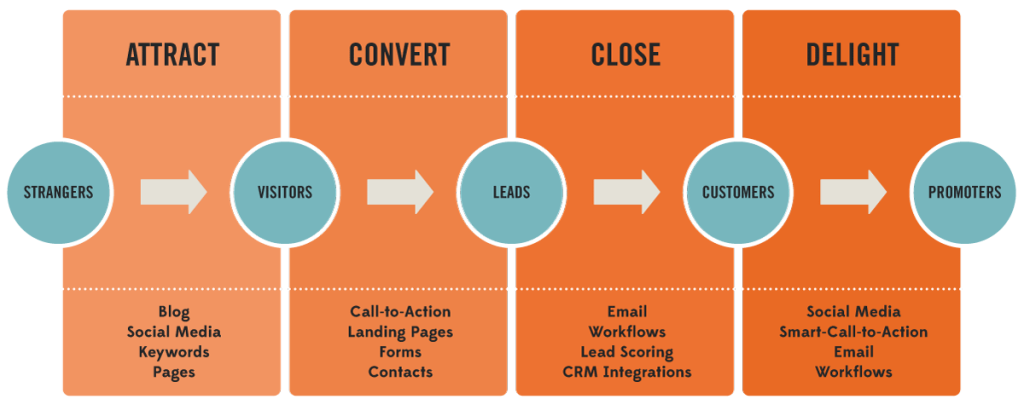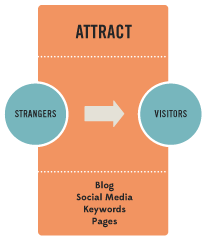
In our previous post, “Inbound Marketing 101: What is Inbound?” we outlined the basics of inbound marketing and the strategies employed to turn your website into an online lead generating machine. In this post, we’ll dig a bit deeper into understanding the first of four marketing actions that drive your audience to convert from a stranger to a lead to a customer and on to a brand enthusiast (promoter) – Attract.
Step One: Attract Traffic to your Website
 The first step to engaging an audience starts with the question: Whose attention do I want to attract? We’ll cover persona development in more detail in another post but, for now, understanding the importance of targeted traffic is key. You don’t want just any traffic to come to your site, you want the right traffic. Getting in front of those decision-makers who are most likely to convert to leads, and, ultimately, happy customers, is paramount. So who are the “right” people? Your ideal customers, also known as “buyer personas”, are blueprints for those people who are most likely to engage with your brand. Personas represent holistic ideals of what your customers are really like – inside and out. Personas detail the goals, challenges, barriers to acceptance of your products and services, as well as personal and demographic information common among members of that specific group of individuals. Personas represent the people around whom your whole business is built and reaching them is the key to your business’ success.
The first step to engaging an audience starts with the question: Whose attention do I want to attract? We’ll cover persona development in more detail in another post but, for now, understanding the importance of targeted traffic is key. You don’t want just any traffic to come to your site, you want the right traffic. Getting in front of those decision-makers who are most likely to convert to leads, and, ultimately, happy customers, is paramount. So who are the “right” people? Your ideal customers, also known as “buyer personas”, are blueprints for those people who are most likely to engage with your brand. Personas represent holistic ideals of what your customers are really like – inside and out. Personas detail the goals, challenges, barriers to acceptance of your products and services, as well as personal and demographic information common among members of that specific group of individuals. Personas represent the people around whom your whole business is built and reaching them is the key to your business’ success.
There are many ways to engage these individuals. Some of the most important tools to attract the right users to your site are:
- Blogging – Inbound marketing starts with the creation of consistent, compelling, on-site materials and frequent posting of fresh content to your website and is the best way to build your audience. Publishing new materials to your website on a regular schedule is the single best way to attract new visitors to your website. In order to be found by your target audience (the right prospective customers), you must create thoughtful, educational, and/or helpful content that speaks to them and answers questions they have about their own personal or business pain points. Blogging tees you up as an industry expert – one willing and ready to help your customers overcome their challenges to reach a specified goal.
- SEO – Creating your online “storefront” is the first step to leveraging the power of the internet to help your business take off, and investment in a website has been shown to have a fantastic ROI. Websites represent fluid outreach for your business. Where print advertising presents the opportunity to publish a static message to your potential customers, your website can be built, tested, and modified over and over to present ever-changing and up-to-date messaging to your audience. That being said, your website can’t live up to its full potential if it is unable to be found by your customers and clients. Your target personas begin their buying process online, usually by using a search engine to find answers to their most pressing questions. So, you need to make sure your site appears prominently when and where they search. To accomplish this task, you need to identify keywords (those terms you are confident your audience will use to find information that relates to your product or service), optimize your pages and posts to perform well in these keyword-driven searches, create content related to these problem/solution key phrases, and build links around the terms for which your ideal buyers are searching. All of this is called “Search Engine Optimization (SEO)” and is the second, important step to your eventual success online.
- Build Pages – Along with your blog, the pages on your website represent your digital storefront. Creating keyword-focused pages that deliver a message that will resonate with your target audience(s) will help ensure that they are provided topical information that presents solutions to their challenges. Leverage information developed while building your personas to optimize your on-page content to speak in a voice (tone) that will appeal to your ideal buyers and transform your website into a beacon of helpful content to entice the right strangers to visit your pages. As before, keywords are also important. Make sure each page of your site presents specific information so that visitors are connected with the information most aligned with their query to really turn your site into an inbound marketing machine.
- Social Publishing – Successful inbound strategies are all about creating remarkable content – that which presents information or solutions to specific challenges faced by your target personas. Publishing information on the social networks where your personas “play” helps you get in front of those audiences and share valuable information with them. In turn, this helps engage with your prospects and puts a human face on your brand. Interact on the networks where ideal buyers spend their time.
Attracting potential customers is the first step to transforming strangers into brand promoters. Once you attract potential clients to your site, you need to convert them from strangers into leads. Learn more about how to convert traffic to a lead in tomorrow’s post.
Did you miss our other Inbound 101 series posts? Here are links to other articles:
